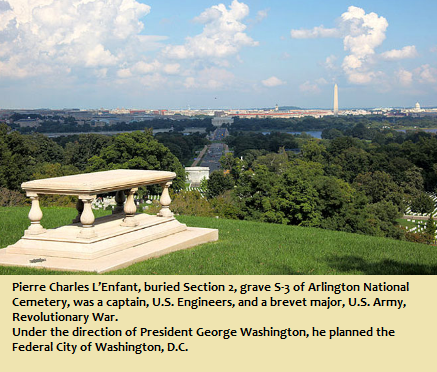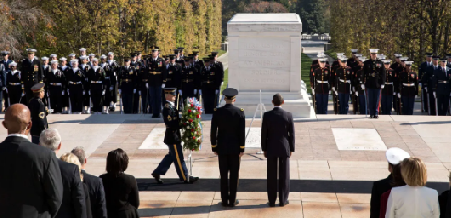Essays Contents
Arlington
May 29, 2023

wikipedia: Arlington National Cemetery
info source
National Park System history
info source
History.com info
info source
From wikipedia, a very good history
Arlington National Cemetery is one of two cemeteries in the United
States National Cemetery System that are maintained by the
United States Army. Nearly 400,000 people are buried in its
639 acres (259 ha) in Arlington, Virginia.
Arlington National Cemetery was established during the American
Civil War after the land the cemetery was built upon, Arlington Estate,
was confiscated from the private ownership of Confederate States
Army general Robert E. Lee's family following a tax dispute.
George Washington Parke Custis was the grandson of Martha Dandridge
Custis Washington (wife of our first president) through her first marriage.
When his natural father, John Parke Custis died, G.W.P. "Washy" Custis
went to live at Mount Vernon where George and Martha Washington raised
him as their own son.

Martha's first husband, Daniel Parke Custis
wikipedia source
At the age of 37, Custis met 16-year-old Martha Dandridge at the St. Peter's Church where Martha attended and Custis was a vestryman. Custis's father John disapproved of the relationship but eventually relented. After a two-year courtship, Custis and Dandridge were married on May 15, 1750. The couple lived at Custis's plantation called the White House in New Kent County, Virginia.
They had four children:
Daniel Parke Custis, Jr. (November 19, 1751 – February 19, 1754)
Frances Parke Custis (April 12, 1753 – April 1, 1757)
John Parke "Jacky" Custis (November 27, 1754 – November 5, 1781)
Martha Parke "Patsy" Custis (1756 – June 19, 1773)
Custis died on July 8, 1757, in New Kent County, Virginia, most likely
of a heart attack.
He is buried in the graveyard of the Bruton Parish
Church in Williamsburg, Virginia
next to two of his children he had
with his wife, Daniel Parke Custis, Jr. and Frances Parke Custis.
Two years after Custis's death, on January 6, 1759, Martha married
George Washington.
As Custis died intestate, or, "without a will", his widow Martha received
the lifetime use of one third of his property (known as a "dower share"),
and the other two thirds was held in trust for their children.
The January 1759 Custis estate also included at least 85 slaves.
According to the Mount Vernon slave census, by 1799 the dower
share included 153 slaves. The October 1759 Custis estate inventory
listed 17,779 acres (71.95 km2), or 27.78 square miles of land,
spread over five counties.
Upon Martha Custis's marriage to George Washington in 1759,
her dower share came under his control, pursuant to the common
law doctrine of seisin jure uxoris. He also became guardian of her
two minor children, and administrator of the Custis estate. John
Parke Custis was the only child to reach his majority, upon which
he inherited the non-dower two-thirds of his father's estate.

In 1802, Custis began building Arlington House on land that he inherited
from his natural father. When completed in 1818, he intended the house
to serve as not only a home but also a memorial to George Washington
(his foster father). In 1804, Custis married Mary Lee Fitzhugh.
They had four children, but only one, Mary Anna Randolph Custis,
survived, and
married future Confederate States Army general Robert E. Lee.
Custis's will gave a "life inheritance" to Mary Lee, allowing her to live at
and run Arlington Estate for the rest of her life but not enabling her to
sell any portion of it. Upon her death, the Arlington estate passed to
her eldest son, George Washington Custis Lee. The house was known
as the Custis-Lee Mansion in the 20th century.
When Virginia seceded from the Union after the start of the U.S.
Civil War at Fort Sumter, Robert E. Lee resigned his commission
on April 20, 1861, and took command of the armed forces of the
Commonwealth of Virginia, later becoming commander of the
Army of Northern Virginia. On May 7, troops of the Virginia
militia occupied Arlington and Arlington House. With Confederate
forces occupying Arlington's high ground, the capital of the Union was
left in an untenable military position.
On May 3, General Winfield Scott ordered Brigadier General Irvin
McDowell to clear Arlington and the city of Alexandria, Virginia, of
all troops not loyal to the United States. Despite not wanting to leave
Arlington House, Mary Lee believed her estate would soon be recaptured
by federal soldiers. On May 14, she buried many of her family treasures
on the grounds and left for her sister's estate at Ravensworth in Fairfax
County, Virginia. McDowell occupied Arlington without opposition on May 24.
At the outbreak of the Civil War, most military personnel who died in
battle near Washington, D.C., were buried at the United States Soldiers'
Cemetery in Washington, D.C., or Alexandria Cemetery in Alexandria,
Virginia, but by late 1863 both were nearly full. On July 16, 1862,
Congress passed legislation authorizing the U.S. federal government
to purchase land for national cemeteries for military dead, and put the
U.S. Army Quartermaster General in charge of this program.
In May 1864, Union forces suffered large numbers of dead in the Battle
of the Wilderness. Quartermaster General Montgomery C. Meigs ordered
that an examination of eligible sites be made for the establishment for a
large new national military cemetery. Within weeks, his staff reported that Arlington Estate was the most suitable property in the area. The property
was high and free from floods (which might unearth graves), it had a
view of the District of Columbia, and it was aesthetically pleasing.
It was also the home of the leader of the armed forces of the Confederate
States of America, and denying Robert E. Lee use of his home after the
war was a valuable political consideration.
The first military burial at Arlington, for William Henry Christman,
was made on May 13, 1864, close to what is now the northeast gate
in Section 27. However, Meigs did not formally authorize establishment
of burials until June 15, 1864.
Arlington did not desegregate its burial practices until President
Harry S. Truman issued Executive Order 9981 on July 26, 1948.
The government acquired Arlington at a tax sale in 1864 for $26,800,
equal to $501,445 today. Mrs. Lee had not appeared in person but rather
had sent an agent, attempting to pay the $92.07 in property taxes
(equal to $1,723 today) assessed on the estate in a timely manner.
The government turned away her agent, refusing to accept the
tendered payment.
Custis Lee, heir under his grandfather's will passing the estate in trust to
his mother, sued the United States in 1874 claiming ownership of Arlington.
On December 9, 1882, the U.S. Supreme Court ruled 5-4 in Lee's favor in
United States v. Lee, deciding that Arlington had been confiscated
without due process. After that decision, Congress returned the estate
to him, and on March 3, 1883, Custis Lee sold it back to the government
for $150,000 (equal to $3,997,273 in 2023) at a signing ceremony with
Secretary of War Robert Todd Lincoln... son of Abraham. The land
then became a military reservation.
President Herbert Hoover conducted the first national Memorial Day
ceremony in Arlington National Cemetery, on May 30, 1929.

The Tomb of the Unknown Soldier stands on top of a hill overlooking Washington, D.C. The tomb was completed and opened to the public
April 9, 1932, at a cost of $48,000. Other unknown servicemen were
later placed in crypts there, and it also became known as the Tomb
of the Unknowns, though it has never been officially named.
The soldiers entombed there are:
Unknown Soldier of World War I, entombed November 11, 1921
Unknown Soldier of World War II, interred May 30, 1958
Unknown Soldier of the Korean War, also interred May 30, 1958
Unknown Soldier of the Vietnam War, interred May 28, 1984
Unknown Soldier of the Vietnam War, interred May 28, 1984;
President Ronald Reagan presided. The remains of the Vietnam
Unknown were disinterred, under the authority of President Bill Clinton,
on May 14, 1998, and were identified as those of Air Force first
Lt. Michael J. Blassie, whose family had them reinterred near their home in St. Louis, Missouri. It has been determined that
the crypt at the Tomb of the Unknowns that contained the remains of
the Vietnam Unknown will remain empty.

The Tomb of the Unknown Soldier has been perpetually guarded since July 2, 1937, by the U.S. Army. The 3rd U.S. Infantry Regiment ("The Old Guard") began guarding the Tomb on April 6, 1948. There is a meticulous routine that the guard follows when watching over the graves. The Tomb Guard:
Marches 21 steps southward down the black mat behind the Tomb
Turns left, facing east for 21 seconds
Turns left, facing north for 21 seconds
Takes 21 steps down the mat
Repeats the routine until the soldier is relieved of duty at the changing of the guard
After each turn, the Guard executes a sharp "shoulder-arms" movement
to place the weapon on the shoulder closest to the visitors to signify that
the Guard stands between the Tomb and any possible threat.
Twenty-one was chosen because it symbolizes the highest military
honor that can be bestowed – the 21-gun salute.
At each turn, the guard makes precise movements followed by a loud
click of the heels as the soldier snaps them together. The guard is changed
every half-hour during daylight in the summer, and every hour during
daylight in the winter and every two hours at night (when the cemetery
is closed to the public), regardless of weather conditions.
There are 396 Medal of Honor recipients buried in Arlington
National Cemetery.

wikipedia: Arlington National Cemetery
info source
National Park System history
info source
History.com info
info source

Martha's first husband, Daniel Parke Custis
wikipedia source
At the age of 37, Custis met 16-year-old Martha Dandridge at the St. Peter's Church where Martha attended and Custis was a vestryman. Custis's father John disapproved of the relationship but eventually relented. After a two-year courtship, Custis and Dandridge were married on May 15, 1750. The couple lived at Custis's plantation called the White House in New Kent County, Virginia.
They had four children:
Daniel Parke Custis, Jr. (November 19, 1751 – February 19, 1754)
Frances Parke Custis (April 12, 1753 – April 1, 1757)
John Parke "Jacky" Custis (November 27, 1754 – November 5, 1781)
Martha Parke "Patsy" Custis (1756 – June 19, 1773)
Custis died on July 8, 1757, in New Kent County, Virginia, most likely of a heart attack.
He is buried in the graveyard of the Bruton Parish Church in Williamsburg, Virginia
next to two of his children he had with his wife, Daniel Parke Custis, Jr. and Frances Parke Custis.
Two years after Custis's death, on January 6, 1759, Martha married George Washington.
As Custis died intestate, or, "without a will", his widow Martha received the lifetime use of one third of his property (known as a "dower share"), and the other two thirds was held in trust for their children. The January 1759 Custis estate also included at least 85 slaves. According to the Mount Vernon slave census, by 1799 the dower share included 153 slaves. The October 1759 Custis estate inventory listed 17,779 acres (71.95 km2), or 27.78 square miles of land, spread over five counties.
Upon Martha Custis's marriage to George Washington in 1759, her dower share came under his control, pursuant to the common law doctrine of seisin jure uxoris. He also became guardian of her two minor children, and administrator of the Custis estate. John Parke Custis was the only child to reach his majority, upon which he inherited the non-dower two-thirds of his father's estate.



